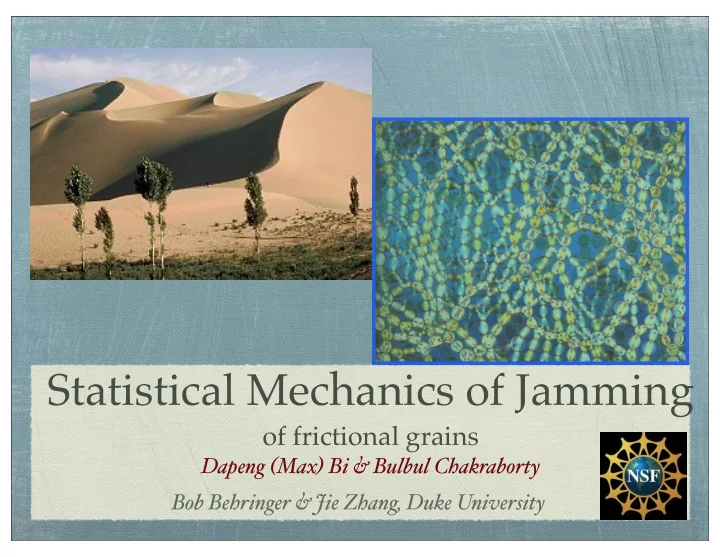

Statistical Mechanics of Jamming of frictional grains Dapeng ( Max ) Bi & Bulbul Chakraborty Bob Behringer & Jie Zhang, Duke University
Jamming “ A wide variety of systems, including granular media, colloidal suspensions and molecular systems, exhibit non-equilibrium transitions from a fluid-like to a solid-like state characterized solely by the sudden arrest of their dynamics.” ( Trappe et al, Nature, 411, 772 (2001)) Dry Granular: A special class since a solid can only be produced through external stress Unjammed Jamming is the phase transition between flows like a them: is this a liquid phase transition? Jammed (resists shear) Increasing volume fraction Granular: Shear can lead to jamming !
Experiments in 2D Packings of Grains with Friction Solidity stems from applied Quasistatic shear stress itself
Jamming Diagram (Old) and (New) � Only Isotropically � Includes Anisotropic states a b Jammed States Unjammed Jammed Unjammed Jammed Shear Jammed Fragile � � � J � S � J ( Cates et al, PRL, 81, 1841 (1998))
Force Networks 1.0 � 0.8 Define k-networks � � � � 0.6 � P � f � � � � � � � f > k f avg 0.4 � � � � � � � � � 0.2 � � � � � � � � 1.0 � � � � � � � � � � � � � � � 0.0 � � � � � � � � � � � � � � � � � � � � � � � � � � � � � � � � 0 1 2 3 4 5 6 f � f �� f � 0.9 � � � � � � f NR threshold 0.8 0.7 � � 0.6 � � 0.5 � � � � � � � � � � � � � � � � � � � � � � � � � � � � � � � � � � � � 0.4 0.3 0.0 0.2 0.4 0.6 0.8 1.0 1.2 k
The fraction of non- rattlers can be used to distinguish between two types of states ( Cates et al, PRL, 81, 1841 (1998))
Phase Diagram Yield-Stress line SJ states have finite yield stress at unjamming (first order transition) Shear-Jammed Fragile
Cyclic Shear Quasistatic cyclic strain creating jammed packings
Percolation (Cyclic Shear) 0.3 ǫ xx 0 � 0.3 1.0 } SJ 0.9 states f NR = 0 . 83 0.8 ξ y /L y for f > 0 cluster ξ y /L y for f > f avg cluster 0.7 ξ x /L x for f > f avg cluster f NR 0.6 0 100 200 300 400 500 600 700 Quasistatic Steps
What types of Solids are these? Response of shear -jammed states Is Point J a special point? Fabric and Stress Relationship Statistical Framework: Force and torque balance are of paramount importance Concept of a Stress Temperature (Angoricity)
Topological Invariants of Mechanically Stable Packings Force and torque balance: Take a continuum approach Cleanest with periodic boundary conditions ( x, L ) ( x + ∆ x, L ) (0 , y + ∆ y ) ( L, y + ∆ y ) (0 , y ) ( L, y ) ( x, 0) ( x + ∆ x, 0)
Stress Ensemble Thermal System Granular materials (athermal) Thermal reservoir (E,V,N) r ν ( x ) � l f f ν x ( x 0 ) x L r r ν ( x ) F x − � � f ν x ( x 0 ) F f x − x The distribution of energy r is then given by: F All blue lines have same y r All blue strips have the same P ( E m ) = 1 F “temperature” wrt to fluctuations Z Ω( E m , V m , m ) e − βE m x Need to consider a collection of 1d systems
Distribution of Local Stresses The probability distribution of stresses in this subsystem ( ) ( )
Stress Ensemble Correctly Predicts Stress Distributions Shear-Jammed states have significant correlations These are less evident for the states above Point J
Correlation Length � f ν x ( x 0 )
Increasing density: tiles become more isotropic area director Force tile for a grain with 5 contacts
Angoricity • The stress distributions of the packings are characterized by a temperature-like quantity, named angoricity • Boltzman-like distribution • Angoricity is a tensor that reflects the intrinsic 1d conservation principle • Correlation length appear is distribution • Fragile/SJ: Phase Transition ? Nematic Model, Simulations Bumpy Particles (with Corey O’Hern)
Recommend
More recommend